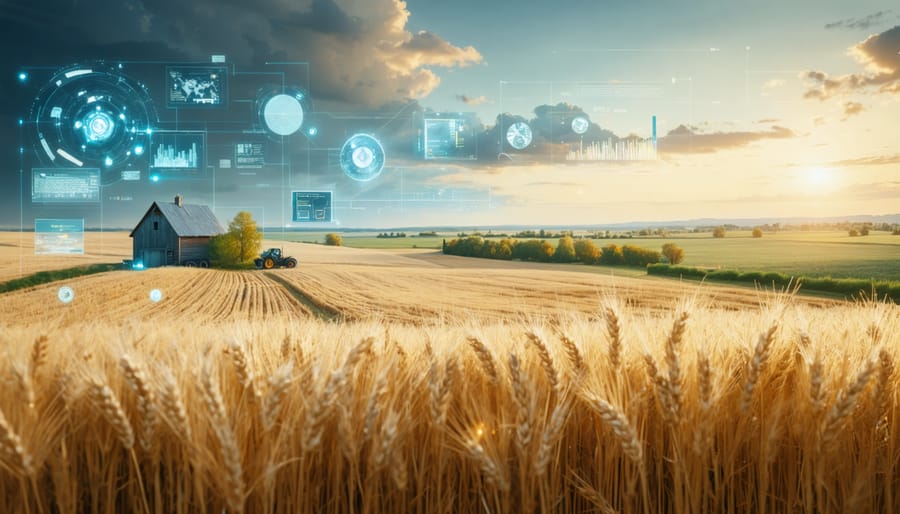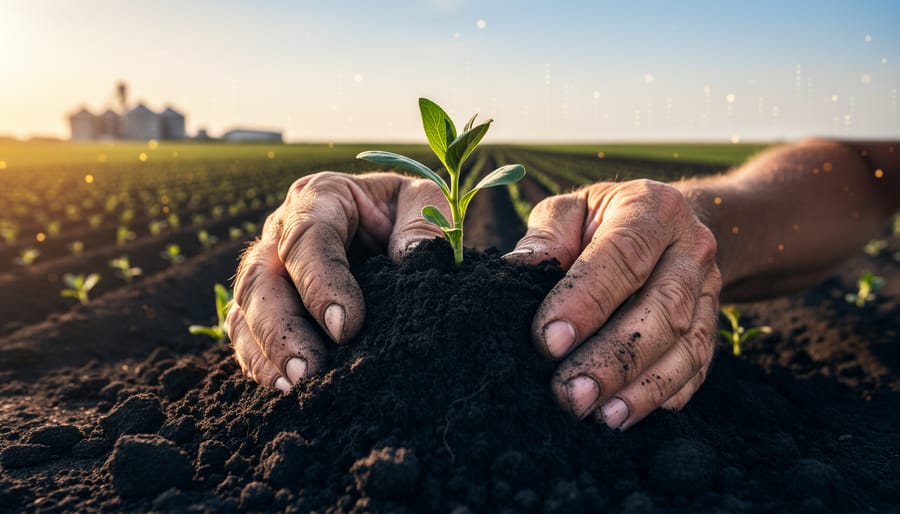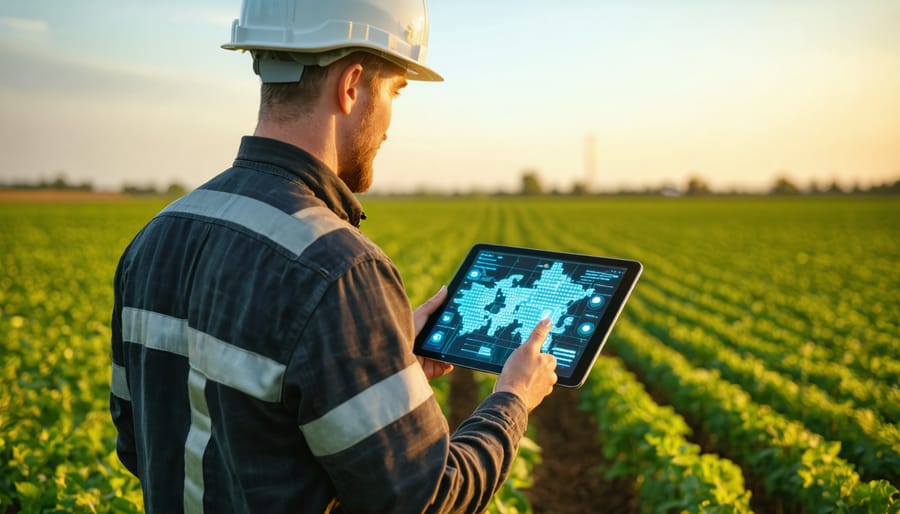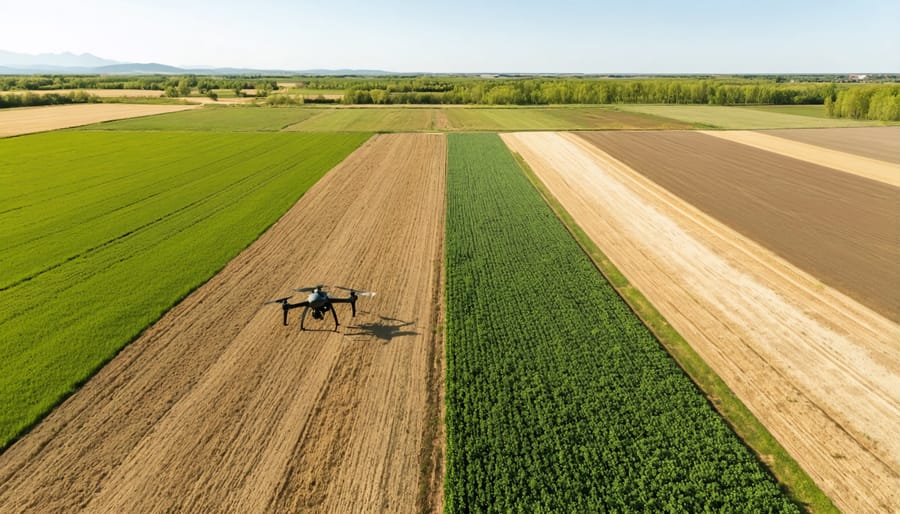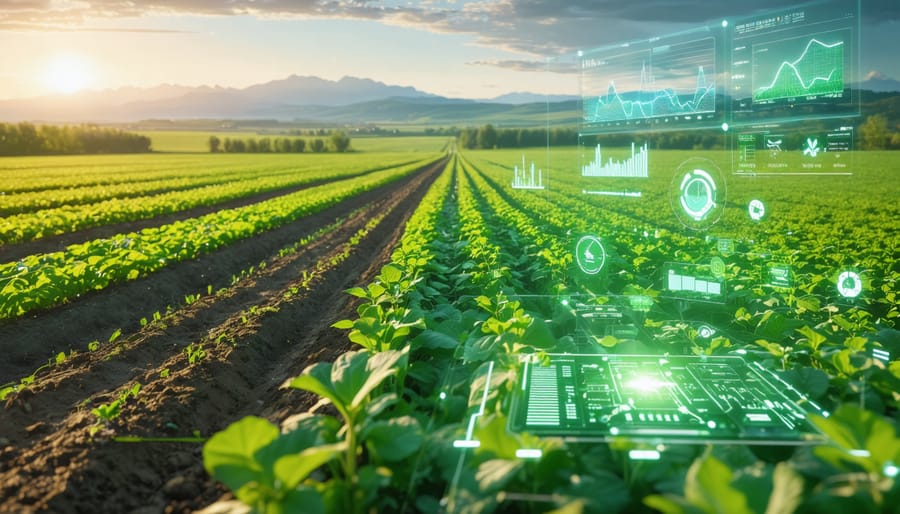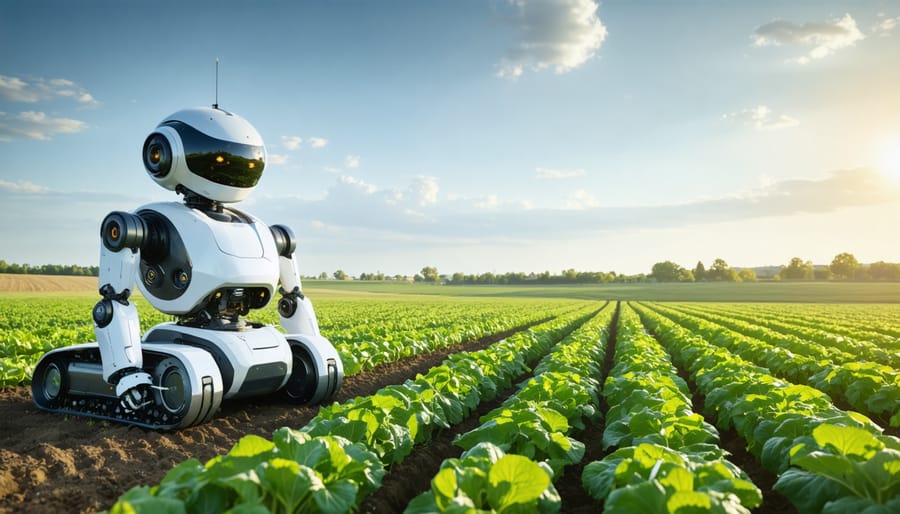Transform your farm’s productivity with AI-powered solutions that are revolutionizing organic precision agriculture across Alberta. Modern farming operations now harness machine learning algorithms to analyze soil conditions, predict optimal planting times, and maximize crop yields with unprecedented accuracy. By integrating smart sensors and automated irrigation systems, Canadian farmers are reducing water usage by up to 30% while increasing crop yields by 20-25% compared to traditional methods.
Real-time data collection through field-mounted IoT devices enables instant decision-making about pest management, fertilizer application, and harvest timing. These AI-driven insights have helped local producers weather unpredictable climate patterns and maintain consistent production levels even during challenging growing seasons. For Alberta’s agricultural community, this technological revolution isn’t just about efficiency—it’s about building resilient, sustainable farming practices that preserve our soil health for future generations while meeting the growing demand for quality organic produce.
The practical impact is clear: farms implementing AI systems report significant improvements in resource management and profitability within their first growing season, making this technology an essential tool for modern agricultural success.
How AI Revolutionizes Organic Crop Yield Prediction
Machine Learning Models for Canadian Soil Conditions
Canadian researchers have developed specialized machine learning models that account for the unique characteristics of Alberta’s prairie soils. These AI systems integrate data from soil testing and monitoring with local climate patterns to provide accurate predictions for crop management.
The models are particularly effective at analyzing the Brown and Dark Brown Chernozemic soils common across Alberta’s agricultural regions. They factor in specific soil properties like organic matter content, moisture retention, and nutrient cycling patterns unique to our prairie landscape.
Local success stories include the Smart Soil Project in Lethbridge, where AI-powered sensors helped farmers reduce water usage by 30% while maintaining yield levels. The system adapts its recommendations based on real-time soil conditions, considering factors like spring thaw timing and frost patterns specific to Alberta’s climate.
These models continue to improve through collaborative efforts between farmers and agricultural scientists, incorporating traditional farming knowledge with advanced technology to create solutions that work for our specific growing conditions.
Real-time Data Processing for Better Accuracy
Modern AI systems in agriculture work like a skilled farm manager who can process multiple streams of information simultaneously. Here in Alberta, farmers are seeing the benefits of AI platforms that can analyze data from various sources in real-time, including soil moisture sensors, weather stations, and satellite imagery.
Take the example of the Smith family farm near Lethbridge, where their AI system processes data from over 50 field sensors every 15 minutes. The system combines this information with local weather forecasts and historical crop data to provide highly accurate predictions for irrigation timing and potential pest outbreaks.
The real power lies in how AI handles these multiple data streams. While a human might take hours to analyze all this information, AI systems can process it instantly, identifying patterns and making recommendations within seconds. For instance, when combining soil moisture readings with approaching weather systems, the AI can suggest precise irrigation schedules that save water while maximizing crop health.
This real-time processing capability means farmers can make more informed decisions exactly when they need to, rather than relying on general guidelines or waiting for visible signs of stress in their crops.

Key Benefits for Alberta’s Organic Farmers
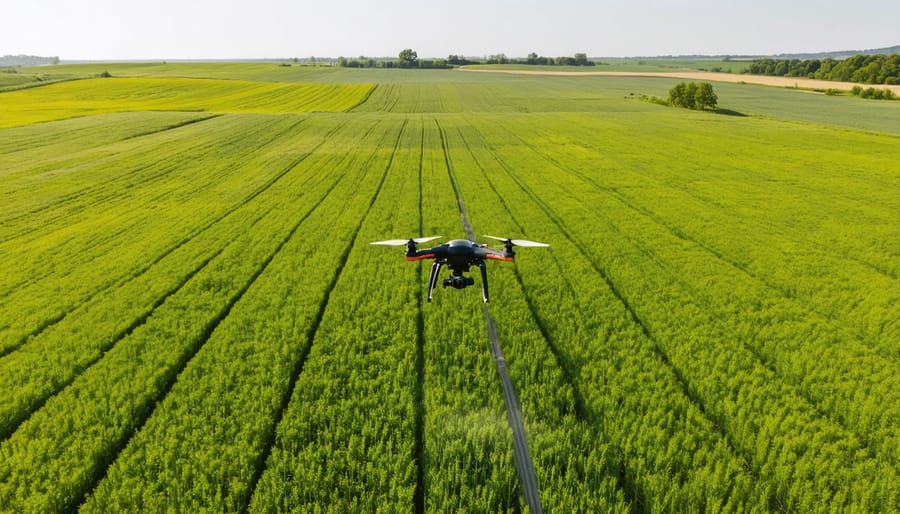
Improved Resource Management
In Alberta’s diverse agricultural landscape, AI-powered systems are revolutionizing how farmers manage their precious resources. Smart sensors and machine learning algorithms now provide real-time soil moisture data, helping farmers make informed decisions about irrigation timing and volume. For instance, at the Peterson Family Farm near Lethbridge, implementing AI-driven irrigation has reduced water usage by 30% while maintaining optimal crop health.
These systems analyze multiple data points, including weather patterns, soil composition, and crop-specific water requirements, to create customized irrigation schedules. The technology is particularly valuable during our unpredictable prairie summers, where efficient water management can make the difference between profit and loss.
For organic fertilizer application, AI tools are equally game-changing. By analyzing soil nutrient levels, crop requirements, and decomposition rates, these systems help farmers apply the right amount of organic amendments at the perfect time. Sarah McKenzie, an organic farmer from Red Deer, reports that AI-guided fertilizer management has cut her input costs by 25% while improving soil health.
The technology also factors in historical field data, weather forecasts, and crop growth stages to optimize resource distribution. This precision approach not only reduces waste but also helps maintain compliance with organic certification requirements while maximizing yield potential. Many Alberta farmers find that these AI systems pay for themselves within two growing seasons through reduced input costs and improved crop performance.
Risk Mitigation Strategies
AI-powered risk mitigation tools are transforming how Alberta farmers approach crop management and protection. By analyzing historical weather patterns, soil conditions, and crop performance data, these systems help farmers make proactive decisions to safeguard their yields.
Take the case of Sarah Thompson, a wheat farmer near Lethbridge, who reduced her crop losses by 30% using AI predictions to optimize irrigation timing. The system analyzed soil moisture levels and weather forecasts to alert her about potential drought stress before visible signs appeared.
These predictive tools are particularly valuable for identifying early warning signs of common challenges like frost damage, pest infestations, and disease outbreaks. For instance, many local farmers now use AI-powered drone imagery to spot potential disease hotspots up to two weeks before they become visible to the naked eye.
Smart sensors and AI algorithms can also help determine optimal planting dates by considering multiple risk factors simultaneously. This technology has proven especially valuable during Alberta’s unpredictable spring seasons, helping farmers avoid late frost damage while maximizing growing days.
To get started with AI risk mitigation, consider:
– Installing soil moisture sensors
– Using weather station data integration
– Implementing drone monitoring systems
– Participating in local data-sharing networks
Remember, these tools work best when combined with your existing farming knowledge and experience. They’re meant to support, not replace, your decision-making process.
Implementation Success Stories
Small-Scale Farm Transformation
The Henderson family farm in Lacombe County demonstrates how AI technology can revolutionize small-scale organic farming success. Sarah Henderson, a third-generation farmer, implemented AI-powered soil monitoring sensors and automated irrigation systems across their 40-hectare property in 2021. The results were remarkable: a 30% reduction in water usage and a 25% increase in crop yields within the first growing season.
“We were skeptical at first,” Sarah shares, “but the technology helped us make better decisions about when to plant, water, and harvest. It’s like having an extra set of eyes watching over every centimetre of our fields.” The Hendersons invested $15,000 in AI technology, including smart sensors and a user-friendly mobile app that provides real-time crop health updates.
The farm now uses predictive analytics to anticipate potential pest problems and optimize fertilizer application. This data-driven approach has not only improved productivity but also reduced their environmental impact. The Hendersons’ success has inspired neighbouring farms to explore similar technologies, creating a ripple effect throughout the local farming community. Their story proves that AI adoption doesn’t require massive scale to be effective – it’s about smart implementation and a willingness to embrace change.
Large Organic Operation Results
Prairie Sky Organics, a 2,000-hectare operation near Red Deer, Alberta, implemented AI-driven yield prediction and pest management systems in 2021, achieving remarkable results within their first full growing season. Owner Sarah Thompson reports a 23% increase in wheat yields and a 17% reduction in crop losses due to more precise pest identification and management.
The farm’s AI system, which processes data from soil sensors, drone imagery, and weather stations, helped optimize irrigation scheduling and reduce water usage by 28% compared to previous seasons. The technology also enabled early detection of nutrient deficiencies in specific field sections, allowing for targeted organic amendments rather than broad-scale applications.
“The system’s ability to predict yield variations across different field sections has transformed how we plan our harvest logistics,” explains Thompson. “We’re now able to coordinate our equipment and labour more efficiently, saving both time and resources.”
The operation also reported a significant improvement in soil health monitoring, with AI-powered analysis helping identify areas requiring additional cover cropping or organic matter amendments. These targeted interventions resulted in measurable improvements in soil organic matter content, increasing from 3.2% to 4.1% across monitored fields within 18 months.
Getting Started with AI Yield Prediction

Essential Tools and Resources
To successfully implement AI in your farming operations, you’ll need a combination of hardware and software solutions. Start with reliable farm management software tools that can integrate with sensors and data collection systems. Essential hardware includes soil moisture sensors, weather stations, and GPS-enabled devices for precision agriculture.
Key components to consider:
– Internet connectivity (minimum 10 Mbps for real-time data transmission)
– Weather-resistant sensors and monitoring equipment
– Smartphones or tablets for field data collection
– Cloud storage solutions for data management
– Drone technology for aerial imaging (optional but beneficial)
Local resources available to Alberta farmers include:
– Agricultural Technology Centre in Lethbridge
– Olds College Smart Farm demonstration facility
– Alberta Farm Extension Services
– Regional precision agriculture consultants
Many of these tools are eligible for funding through the Canadian Agricultural Partnership (CAP) program. Consider starting with basic monitoring equipment and gradually expanding your technological infrastructure as you become more comfortable with the systems. Remember to factor in training time for your team and regular system maintenance in your implementation plan.
Support is readily available through local agricultural extension offices and technology vendors who specialize in Canadian farming operations. Many offer free trials and demonstrations to help you make informed decisions about which tools best suit your specific needs.
Training and Support Networks
Alberta offers numerous resources and support networks to help farmers integrate AI technologies into their operations. The Olds College Smart Farm leads the way with hands-on training programs that combine classroom learning with practical field experience. Their specialized workshops cover everything from basic AI concepts to advanced precision agriculture techniques, making technology adoption more accessible for farmers at all skill levels.
The Alberta Agriculture and Forestry department regularly hosts regional tech seminars and provides online learning modules through their digital learning platform. These resources are particularly valuable for remote farmers who may not have easy access to in-person training facilities.
Local agricultural societies across the province have established mentor networks, connecting experienced AI-adopting farmers with those just starting their digital transformation journey. These partnerships have proven invaluable in sharing real-world experiences and practical implementation strategies.
The Farm Tech Solutions Network, a collaborative initiative between various agricultural organizations, offers monthly webinars and hands-on demonstrations at demonstration farms throughout Alberta. Their support includes technical troubleshooting assistance and guidance on integrating new AI tools with existing farm management systems.
For ongoing support, the Alberta Ag-Tech Connect forum serves as an online community where farmers can share experiences, ask questions, and stay updated on the latest AI developments in agriculture. This platform has become a vital resource for problem-solving and knowledge sharing among the farming community.
As we’ve explored throughout this article, AI-powered prediction tools are revolutionizing organic farming practices across Alberta and beyond. These innovations offer our farming community powerful advantages: increased crop yields, reduced resource waste, and better adaptation to our unique Canadian climate challenges. By embracing these smart farming solutions, organic producers can enhance their decision-making capabilities while maintaining their commitment to sustainable agriculture.
The success stories from local farms demonstrate that AI technology isn’t just for large-scale operations – farms of all sizes are benefiting from these tools. Whether it’s predicting optimal planting times, managing pest control more effectively, or planning irrigation schedules, AI supports the core principles of organic farming while improving productivity and profitability.
As we look to the future of agriculture in Alberta, the integration of AI prediction tools represents a natural evolution in organic farming practices. By starting small and gradually incorporating these technologies, farmers can build confidence while seeing tangible results. The support network of agricultural extension services, tech providers, and fellow farmers makes this transition more accessible than ever.
Let’s continue working together to build a more sustainable and productive agricultural future, one prediction at a time.

